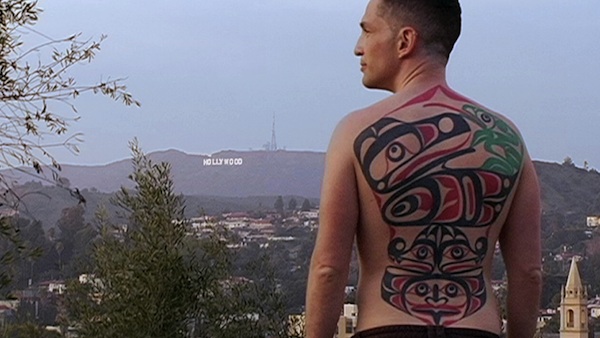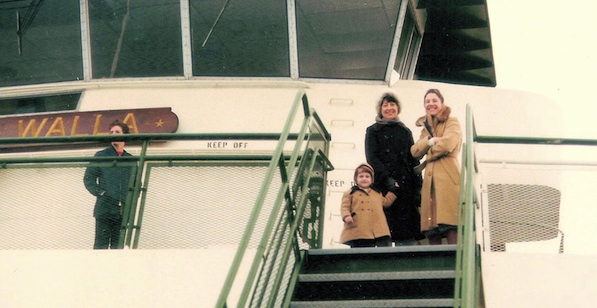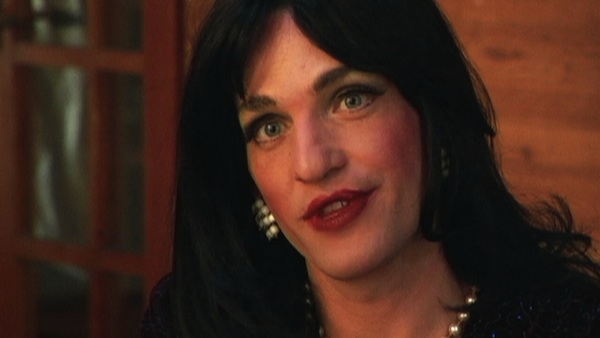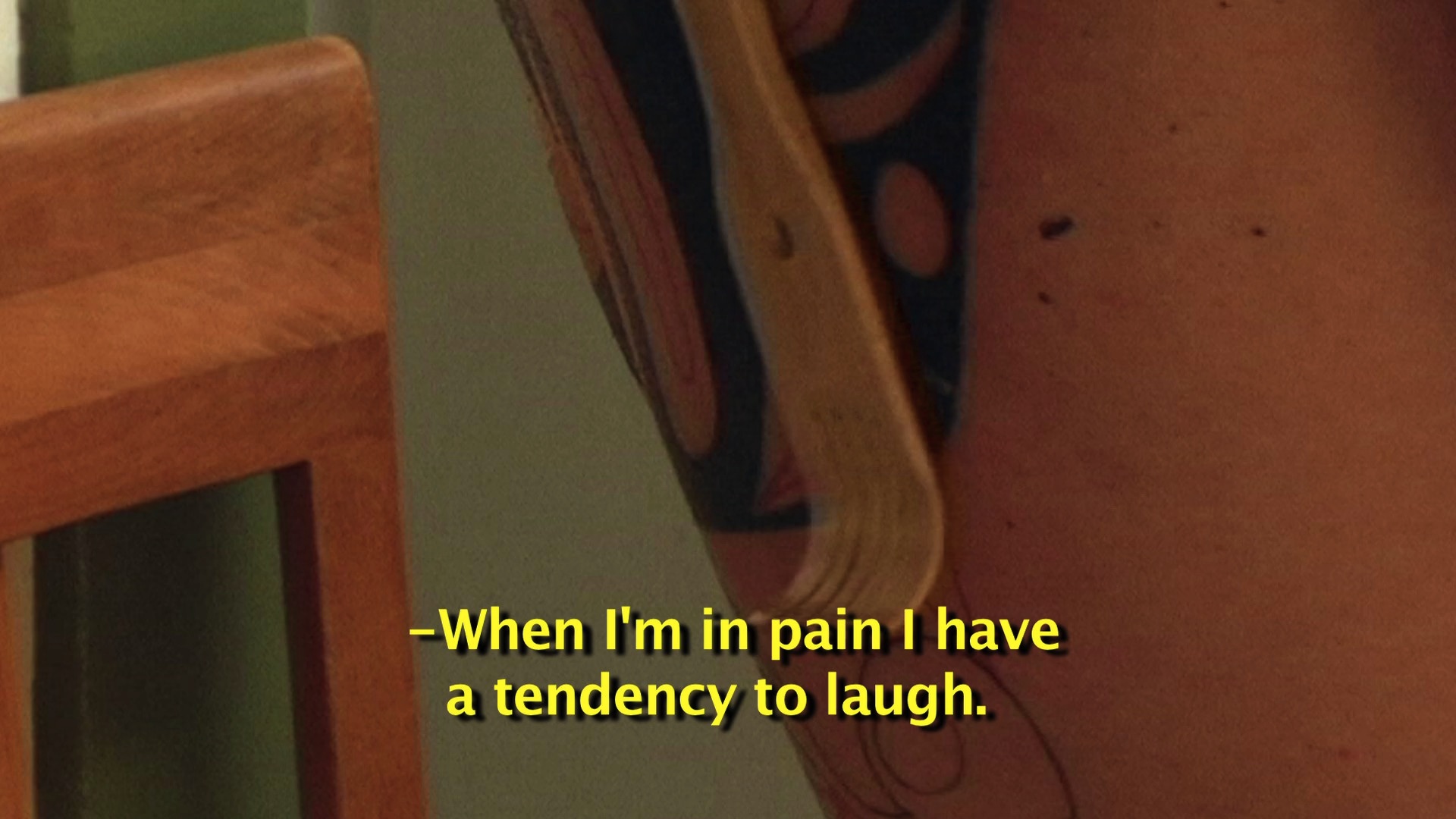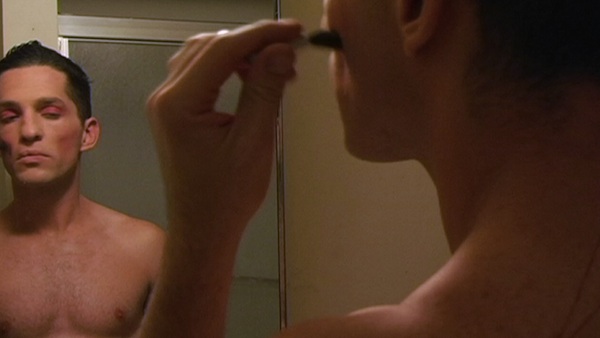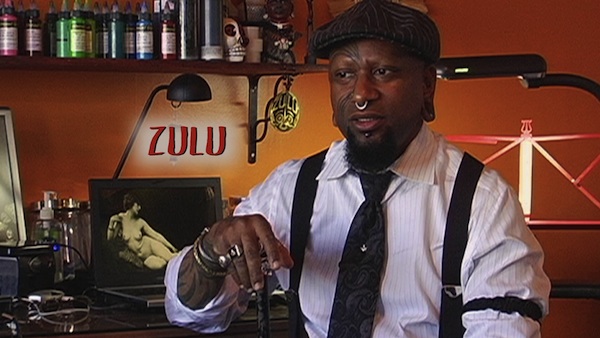A child photographer who grew into a full-fledged self-reflexive 21st-century cine-autobiographer, Broderick Fox has occupied many identities, and his latest—The Skin I’m In—is not so much an integration of those identities as a coming-to-terms with the plural possibilities of a life. Anchored by the creation of a piece of permanent body art, The Skin I’m In takes Fox back to a horrifying blackout in Germany through awkward years of searching to a mature desire to plant his feet on ground (be it solid or shifting). Fox has created a number of short works along the way, including “alternative home movie” Things Girls Do and coming-of-age doc Home. Fox spoke to me last month as part of our series on personal documentary films.
Keyframe: This piece about art and identity and coming of age covers so much ground. Why did you decide to open it with the creation of a tattoo?
Broderick Fox: As the film shows, I was really privileged in that my parents gave me a Kodak 110 camera when I was six. I’d moved up to 35mm cameras by the age of ten. So for better or for worse, my entire life, I’ve looked at things through a viewfinder and shot film and video to make sense of the world. When I was in that dark place in 2005 with alcohol, I’d already been through grad school and had trained as a filmmaker. I was making films and thinking critically about films, when I decided I was going to go on this bodily journey with the tattoo, so it was just an innate instinct to document the process. The great thing about autobiographical work is there’s no controlling producer, financing agent, or other subjects waiting for the film. I can just decide I’m going to capture material and see if there’s something worth sharing publicly at the other end. With The Skin I’m In that process was a long one: I started the tattoo in 2006 the film finished in 2012. It was quite a journey.
Keyframe: Speaking of journeys, your mother’s initial journey through Pan Am and your early life as a world traveler is really fascinating. I wonder if you can give a little more biographical background to that. What countries did you live in and what were your parents doing there?
Fox: My father was a corporate attorney and he got transferred to Japan. So I moved to Japan when I was just about to turn seven and left just after I turned eleven. Some pretty formative years to live in Tokyo, in the eighties, in a global context that in many respects doesn’t exist anymore. Living in Japan, we were afforded the chance to travel across Southeast Asia, parts of Africa. I had this amazing opportunity to see the world before I’d even gone through puberty.
Keyframe: Your worst culture shock, you mention, was landing in the U.S. What were the biggest difficulties to overcome when you returned?
Fox: Living in Japan in those formative years, I went to an international school where everybody was different or distinct in their own way. Difference was the norm. You were constantly being exposed to other cultures, other perspectives. When I moved back to the U.S. it was to a rural part of New Jersey, which was a place of real contradiction. Incredibly beautiful countryside, and yet only forty miles from Manhattan. A lot of blue-collar/factory and farm workers whose jobs had dried up living alongside the Malcolm Forbes and Johnson & Johnson estates and the U.S. Equestrian Center, so a lot of contrasts. I went to a regional public high school and a lot of those kids had been together in this community since kindergarten. I was the outsider. And then a number of additional factors complicated things: being small for my age, not being able to go to the Gap and buy on-trend clothes that fit me; being intelligent and quick in school, which can put a target on your back; having lived abroad, which made me weird in their eyes; and then of course, realizing as I approached puberty that I was gay as well. So there were a slew of different factors that set me apart. And on some level I’d always had this feeling of disconnect from my physical body: a disconnect between my internal conception of self and my imagination, and the material reality of my body. That disconnect was pronounced from an early age.
Keyframe: Much of this film concerns the performance of ‘self.’ What of your previous works—documentary and narrative shorts—most influenced this one?
Fox: Much to the horror of my production M.F.A. professors at USC’s School of Cinematic Arts I went on and completed a Ph.D. in Critical Media Studies there. Those years of dissertation writing were somewhat lonely years, but I was profoundly influenced by my doctoral work with Dr. Michael Renov who is one of the pioneering documentary scholars and a champion of the autobiographical act, the possibilities afforded by video to put oneself under investigation in ways that were not possible with film. The immediacy of video, the possibility to play it back and edit it, these capacities have become second nature to a large portion of the population. I have a certain shyness combined with a meticulous controlling nature which made it ideal to turn to myself as subject. Both the Things Girls Do and Home pieces that are available on Fandor were works inspired by critical thinking and a certain degree of isolation and introspection that going through a doctoral program produces.
Things Girls Do starts to question the idea that identity is a knowable and essentializable thing. There’s intentional play with the mutability of identity in that film. By the time I arrived at The Skin I’m In, I found the autobiographical act highly suspect, in a good way. There are so many different access points and ways you can get at a life story, so many details to choose from in making a film about thirty years of life, so many ways to structure the narrative…an autobiography is going to be inherently selective and subjective. Any representational act is for that matter, but making claims about your own life puts the subjective act under extreme scrutiny. Rather than that being a point of representational crisis, I see that as a real creative opportunity—hence the play with five different personas in The Skin I’m In, that ultimately add up to a life.
Keyframe: How long have you been teaching at Occidental? The program sounds interesting. And in The Skin I’m In, the ‘teaching Dziga Vertov‘ moment is fascinating. Can you elaborate on that?
Fox: I’ve been a professor at Occidental for ten years now. Vertov’s Man with a Movie Camera is one of those films that I screen in a lot of different class contexts. I show it in documentary class contexts to look at reflexive modes of documentary, but the instance that I mention in The Skin I’m In occurred in an Aesthetics of Cinema class as part of a unit on approaches to formalist and reflexive editing that challenge traditional classical Hollywood models of transparency. I was watching the film, and there’s a scene of first responders arriving at the scene of a traffic accident. And in those images, which I’d seen countless times before, I suddenly saw myself and was forced to come to terms with the emotional magnitude of my own near-death experience. A pretty powerful teaching moment, to say the least.
Keyframe: The place you arrive at in the film is art as legacy—creation vs. ‘procreation’–is a wonderful ending point for this piece.
Fox: I think for such a stretch my sexuality was a burden, and a sticking point, something that closed relationship down and came with fear associated with it. The passage in the film where I show a montage of gay heroes from across time is meant to inspire each of us to recognize the essential, numinous spark…the generative, productive, and celebratory aspects at the heart of queer culture. When I use the word ‘queer’ I certainly reference my own sexuality, but in the true sense of queer theory, expand that out to any means of stepping outside of dominant structures. Looking at any aspect of life or culture from a bent angle or an alternative perspective. That montage is a love letter for me to LGBT artists and spirits throughout history that, certainly because of their sexuality, tapped into that queer spirit. Their difference generated an incredible capacity to create ideas and art that were culturally transformative beyond themselves. I try to ask some tough questions in the movie about mainstream gay culture—about the place for intimacy and spirituality in a gay culture largely reduced to external performances of sex and social status; about the ways mainstream culture has appropriated and sold gay culture back to us as a commodity. I want to inspire everybody, whether they’re gay or straight, to get beyond these tropes and reclaim queerness as a way of approaching the world through unconditioned eyes.
Though this film started off as a solitary act of documenting the tattoo, the tattoo was not something that I could have done alone. It put me in touch with two men, Canadian First Nations artist Rande Cook and L.A. tattoo artist Zulu, and though all of us come from very different backgrounds, there are interesting parallels to our lives: each of us questioned the norms of the culture we’re in and found a way to investigate those questions through art. Through the tattooing process, the solitary autobiographical act of filmmaking was transformed into a communal and collaborative artistic process of transformation.
So much of my pain and suffering had been caused by self-imposed, cerebral isolation. I had lived so much in my mind, and wreaked so much havoc on my body; I’d eschewed organized religion, and in doing so had never fostered or cultivated any sense of spirit for myself. As ‘New Age Californian’ as it may sound, with the tattoo and the film I unconsciously created a communal rite of passage, a way to look at myself, reflect, and grow into new relationship between mind, body and spirit. My relationships with Rande and Zulu, the opportunity to clear the air and start new relationships with my family—these are gifts of the process that transcend the physical the tattoo or the finished film.
Keyframe: Did you get pushback on this project?
Fox: When I was describing the project once, a fellow filmmaker quipped, ‘Oh, an autobiographical documentary. That’s so Sundance 1992.’ This idea that self-reflection through media or engagement with identity politics are things of a past moment. I assume he was referencing that powerful moment of queer and feminist makers like Marlon Riggs, Tom Joslin, Vanalyne Green,and Lynn Hershman [Leeson] who were using early video to make the personal political. I proudly cite those individuals as creative influences. I started this film in 2005, in a pre-Facebook moment when YouTube had only just launched. Now acts of mediated self-exposure have become a digital commonplace. But in our digital moment where everything is so instant, what often gets lost is the delay and the retrospective distance and pause analog media afforded, which I think added depth and artistry to acts of self-inscription.
My goal is to revive those legacies in the digital age. The technologies that I used to make this movie are ones that people have in their possession now on their phones and on computers in their homes or community centers. And there’s nothing extraordinary about my story; the art comes in the telling. My hope is that The Skin I’m In inspires others to use the digital tools at their disposal to ask questions, challenge norms, engage in self-reflection and play.

